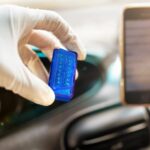Encountering car starting problems can be frustrating, especially when the symptoms are intermittent and point to electrical issues. One perplexing scenario involves a malfunctioning Engine Control Unit (ECU), which can manifest in unusual ways, sometimes even affecting your ability to read diagnostic codes via the OBD2 port.
Imagine this: you turn the key, and the engine cranks but doesn’t start. Initially, you might suspect a low battery or alternator problem, especially if the cranking sounds weak. You might even notice a strange, hollow cranking sound, perhaps leading you to suspect timing belt issues. However, after verifying these common culprits, the problem persists.
The check engine light (CEL) becomes a crucial indicator, but in the case of a failing ECU, its behavior can be erratic. Instead of a steady light or consistent code flashes, you might observe the CEL lighting up for only a fraction of a second, then disappearing, or blinking randomly without entering diagnostic test mode. This inconsistent CEL behavior is a strong symptom of potential ECU trouble.
Further investigation might involve checking relays and power supply to the ECU, but the issue remains. Interestingly, after attempting to charge the battery, the CEL might become more stable, though still erratic. At this point, the engine might struggle but eventually start. However, after shutting it off, the problem returns – the engine cranks with that hollow sound, the CEL disappears again, and it refuses to start. This cyclical behavior, where the car starts intermittently and the CEL acts erratically, strongly suggests the ECU is cutting out fuel and spark signals inconsistently.
If you’re experiencing these symptoms, especially the erratic CEL behavior and intermittent starting, a failing ECU is a prime suspect. While ECUs can fail in various ways, this type of intermittent malfunction, potentially coupled with an inability to reliably connect with an OBD2 scanner due to the ECU’s instability, is a telltale sign. Further diagnostics, possibly involving ECU replacement, are necessary to confirm and resolve the issue.
